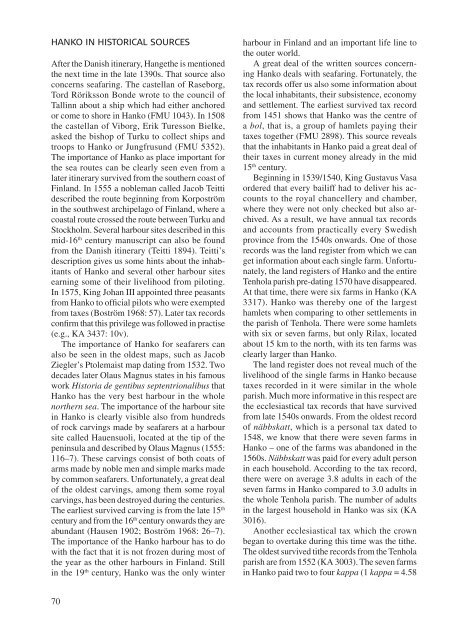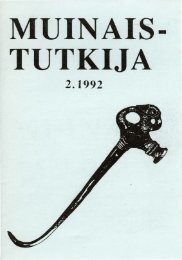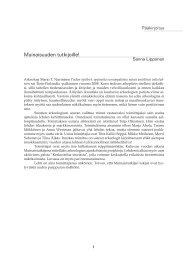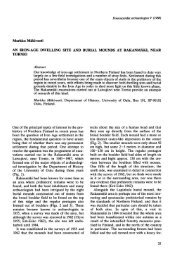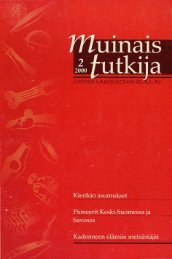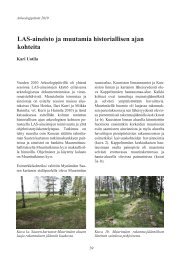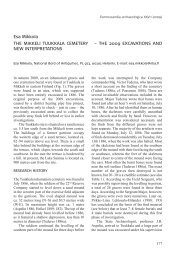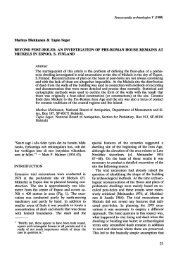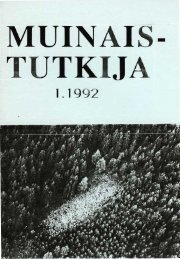Henrik Jansson, Georg Haggrén, Kristiina Mannermaa & Tanja ...
Henrik Jansson, Georg Haggrén, Kristiina Mannermaa & Tanja ...
Henrik Jansson, Georg Haggrén, Kristiina Mannermaa & Tanja ...
Create successful ePaper yourself
Turn your PDF publications into a flip-book with our unique Google optimized e-Paper software.
HANKO IN HISTORICAL SOURCESAfter the Danish itinerary, Hangethe is mentionedthe next time in the late 1390s. That source alsoconcerns seafaring. The castellan of Raseborg,Tord Röriksson Bonde wrote to the council ofTallinn about a ship which had either anchoredor come to shore in Hanko (FMU 1043). In 1508the castellan of Viborg, Erik Turesson Bielke,asked the bishop of Turku to collect ships andtroops to Hanko or Jungfrusund (FMU 5352).The importance of Hanko as place important forthe sea routes can be clearly seen even from alater itinerary survived from the southern coast ofFinland. In 1555 a nobleman called Jacob Teittidescribed the route beginning from Korpoströmin the southwest archipelago of Finland, where acoastal route crossed the route between Turku andStockholm. Several harbour sites described in thismid-16 th century manuscript can also be foundfrom the Danish itinerary (Teitti 1894). Teitti’sdescription gives us some hints about the inhabitantsof Hanko and several other harbour sitesearning some of their livelihood from piloting.In 1575, King Johan III appointed three peasantsfrom Hanko to official pilots who were exemptedfrom taxes (Boström 1968: 57). Later tax recordsconfirm that this privilege was followed in practise(e.g., KA 3437: 10v).The importance of Hanko for seafarers canalso be seen in the oldest maps, such as JacobZiegler’s Ptolemaist map dating from 1532. Twodecades later Olaus Magnus states in his famouswork Historia de gentibus septentrionalibus thatHanko has the very best harbour in the wholenorthern sea. The importance of the harbour sitein Hanko is clearly visible also from hundredsof rock carvings made by seafarers at a harboursite called Hauensuoli, located at the tip of thepeninsula and described by Olaus Magnus (1555:116–7). These carvings consist of both coats ofarms made by noble men and simple marks madeby common seafarers. Unfortunately, a great dealof the oldest carvings, among them some royalcarvings, has been destroyed during the centuries.The earliest survived carving is from the late 15 thcentury and from the 16 th century onwards they areabundant (Hausen 1902; Boström 1968: 26–7).The importance of the Hanko harbour has to dowith the fact that it is not frozen during most ofthe year as the other harbours in Finland. Stillin the 19 th century, Hanko was the only winterharbour in Finland and an important life line tothe outer world.A great deal of the written sources concerningHanko deals with seafaring. Fortunately, thetax records offer us also some information aboutthe local inhabitants, their subsistence, economyand settlement. The earliest survived tax recordfrom 1451 shows that Hanko was the centre ofa bol, that is, a group of hamlets paying theirtaxes together (FMU 2898). This source revealsthat the inhabitants in Hanko paid a great deal oftheir taxes in current money already in the mid15 th century.Beginning in 1539/1540, King Gustavus Vasaordered that every bailiff had to deliver his accountsto the royal chancellery and chamber,where they were not only checked but also archived.As a result, we have annual tax recordsand accounts from practically every Swedishprovince from the 1540s onwards. One of thoserecords was the land register from which we canget information about each single farm. Unfortunately,the land registers of Hanko and the entireTenhola parish pre-dating 1570 have disappeared.At that time, there were six farms in Hanko (KA3317). Hanko was thereby one of the largesthamlets when comparing to other settlements inthe parish of Tenhola. There were some hamletswith six or seven farms, but only Rilax, locatedabout 15 km to the north, with its ten farms wasclearly larger than Hanko.The land register does not reveal much of thelivelihood of the single farms in Hanko becausetaxes recorded in it were similar in the wholeparish. Much more informative in this respect arethe ecclesiastical tax records that have survivedfrom late 1540s onwards. From the oldest recordof näbbskatt, which is a personal tax dated to1548, we know that there were seven farms inHanko – one of the farms was abandoned in the1560s. Näbbskatt was paid for every adult personin each household. According to the tax record,there were on average 3.8 adults in each of theseven farms in Hanko compared to 3.0 adults inthe whole Tenhola parish. The number of adultsin the largest household in Hanko was six (KA3016).Another ecclesiastical tax which the crownbegan to overtake during this time was the tithe.The oldest survived tithe records from the Tenholaparish are from 1552 (KA 3003). The seven farmsin Hanko paid two to four kappa (1 kappa = 4.5870


